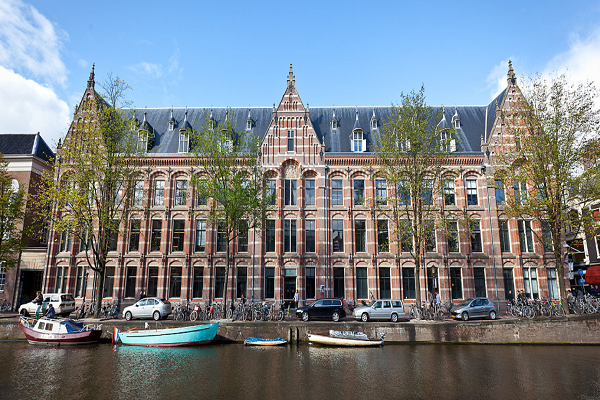University of Amsterdam: Original UvA lab of chemistry Nobel laureate Van ‘t Hoff is ‘Chemical Landmark’
The first Amsterdam laboratory of Johannes Henricus van ‘t Hoff has been declared ‘Chemical Landmark’ by the chemical society KNCV. A plaque was unveiled this afternoon during a short ceremony at Groenburgwal 44. There Van ‘t Hoff conducted his research for which he received the very first Nobel Prize in Chemistry in 1901.
The building is currently used as a café and exhibition space, but until 1891 it served as the chemical laboratory of the University of Amsterdam. It was here that Jacobus Henricus van ‘t Hoff (1852-1911) conducted the experiments that won him the Nobel Prize in Chemistry in 1901. This was for his research in the field of chemical dynamics and in particular the osmotic pressure of solutions. He also acquired fame for his research into the spatial structure of molecules and the precise arrangement of the atoms in that structure.
A productive period
Although Van ‘t Hoff was not particularly enthusiastic about the UvA laboratory facilities when he was appointed in 1877, he spent a very productive period at Groenburgwal 44. There he wrote his book Études de dynamique chimique, published in 1884, in which he laid the foundations for the discipline that we know today as physical chemistry. His work made a great impression internationally and in 1887 he received an offer from Leipzig to become a professor. To retain him for the university and the city, Amsterdam built a brand new chemistry lab on Roeterseiland. Van ‘t Hoff took it into use in 1891, but his Dutch career was not to last. In 1895, he accepted a new offer, this time from the Prussian Academy of Sciences in Berlin. There he worked until his death in 1911.
In Amsterdam, the Van ‘t Hoff name lives on in the current Van ‘t Hoff Institute for Molecular Sciences, which was founded in 2004. The Van ‘t Hoff laboratory on the Roeterseiland was ravaged by fire on 7 November 1987 and subsequently demolished. The chemical researchers at the time had moved to a more modern laboratory some years earlier.
Nowadays, they work at Amsterdam Science Park, where one of the roof ornaments of the burnt down Van ‘t Hoff laboratory is still on display. In the hall of the REC-E building on today’s Roeterseiland complex is a small gate in which some remnants of that lab have been incorporated.

